Australia
Map
Flag
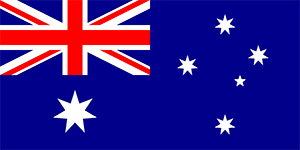
Quick facts
Official Name: Commonwealth of Australia
Indigenous Peoples: Aboriginal Australians or Indigenous Australians (including Torres Strait Islanders and Tasmania Aborigines)
Official Languages: English
Political Status: Constitutional Monarchy with Federal Parliamentary Democracy
Capital: Canberra
Population: 22,751,014 (July 2015 est.)
Greeting: G’day mate
Australia, often touted as the world’s largest island but smallest continent, is home to aboriginal and indigenous oceanic peoples. With a total area of 7.69 million sq km, Australia is divided into six states and two territories. It is the sixth largest nation in the world and the only continent that is governed as a single country. The population is roughly 23 million people.
The Australian continent was occupied for about 50,000 years prior to the establishment of the first British settlement in the late 1700s. Indigenous Australians, or Aborigines, were comprised of about 250 different language groups. After Australia was “discovered” by Dutch explorers in 1606, Great Britain claimed half the continent in 1770, establishing a penal colony in 1788. More people began to explore and settle the continent over the next two centuries. By 1901, the six self-governing crown colonies that had been established eventually joined to form the Commonwealth of Australia.
Australia is a constitutional monarchy with three levels of government: the federal Australian Government, the state and territorial governments, and local government authorities. Queen Elizabeth II of the United Kingdom is the Head of State, and she appoints the Governor-General as her representative. The Governor-General appoints ministers under the advisement of the Prime Minister.
Although most residents of Australia are immigrants or descendants of immigrants from the last 200 years, the Aboriginal and Torres Strait Islander people have inhabited Australia for thousands of years. Tasmania is one of the six states and is separated from mainland Australia by Bass Strait. Originally founded as a penal colony, the capital, Hobart, is Australia’s second oldest capital after Sydney. One-fifth of the state is covered with national parks and wilderness areas, and its mountainous terrain reflects Australia’s past connection with Antarctica millions of years ago.
History and geography
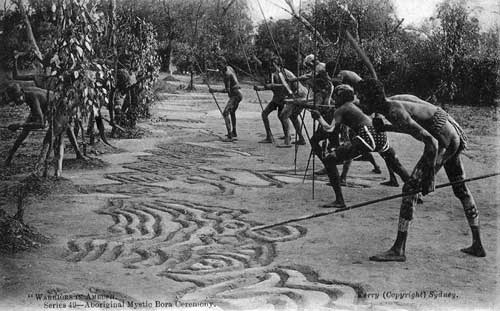
Indigenous Australians are members of groups that existed in the continent of Australia and the surrounding islands prior to European colonization. Indigenous Australians are sometimes referred to as Aboriginals or Aborigines. The term is broad, but the indigenous Australians are comprised of ethnically diverse groups of people, which include the Tiwi people, Nyoongar people, the indigenous people in Tasmania, and Torres Strait Islanders, who are indigenous to the Torres Strait Islands located at the northernmost tip of Queensland near Papua New Guinea.
Although archeological evidence points to Australia having been inhabited as early as 40,000 years ago, it is not entirely clear what the relationship is between these early inhabitants and modern indigenous Australians. There is also evidence that the arrival of humans into Australia dates back even further to about 125,000 years ago. However, more recent studies assert that modern indigenous Australians descended from the first modern humans that migrated out of Africa to Asia 70,000 years ago and arrived in Australia about 50,000 years ago.
The diversity of indigenous Australians is impressive, varying in cultures, customs and languages. There are over 250 languages spoken, with 120 to 145 of these languages still in use, and all but 13 in danger of being lost due to lack of speakers. English is the common language shared by all Australians, but the addition of Aboriginal words has led to a kind of Australian Aboriginal English that is in use today.
By the time Europeans arrived there were about 318,000 to 1,000,000 indigenous Australians, mostly living in southeast Australia in the River Murray Valley in particular.
As British settlers continued to explore and settle the wide expanse of the Australian continent, the displacement of the Aboriginal peoples was only a matter of time. In the 1880s, after bloody conflicts and guerrilla warfare by Aborigines and the white settlers, most of the natives were forced to assimilate with the rest of the population, joining white rural and urban communities or camps on the fringes of towns where they became marginalized and exposed to disease. Many died and some Aboriginal tribes became extinct. Some groups were sent to special government-controlled reserves or Church missions where they were treated badly. In the 1890s and after World War I, many of the reserves were closed and the land was taken away by non-Aboriginal people for farming.
In the 1920s a new approach was used to deal with the “Aboriginal problem:” children were stolen from their parents and placed in homes where they were trained to learn the ways of white people. Boys were trained to become farm laborers and girls as domestic servants. The official policy of assimilation in the 1930s decided that Aboriginal people should “become white” and live as other white Australians.
By the 1960s it was clear the Aboriginal peoples had neither died off completely or assimilated fully, thus began the modern land rights movement and the development of the Federal Council for the Advancement of Aborigines and Torres Strait Islands (FCAATSI), the first national organization of indigenous Australians.
By the 1970s civil rights disputes gained attention as Aboriginal Australians spoke out for equal rights and for land rights to property that had been forcibly taken away by British settlers. In 1976, the Aboriginal Land Rights Act was passed. By the 1990s, more legislation was passed further increasing autonomy among the Aboriginal peoples, and increasing wages and welfare benefits, and opening doors to finally return land titles to traditional owners.
Aboriginal culture
At the time of European contact there were about 250 individual, clan-based cultural groups or nations, many of whom were in alliance with each other. Each had their own language and customs; some had several languages. Other sources claim there were about 500-600 distinct groups. They shared some cultural characteristics, including strong spiritual beliefs and connectedness to the land, storytelling and art.
Indigenous Australians lived mainly as hunter-gatherers. Aboriginal society was generally mobile, or semi-nomadic, moving when the seasons changed or to where food sources were more available. Some groups had permanent settlements made of saplings covered with thatch of locally available materials, and even engaged in agriculture. Gender roles were complementary, with each contributing to the survival of the group as a whole. Women were primarily the gatherers, collecting vegetables, roots, herbs, fruits, nuts and eggs and small animals. Men hunted the large animals and birds, organizing hunting parties to capture kangaroos and emus.
Groups traded with each other for natural resources such as ochres, pearl shells, tools, stone axes, didgeridoos and boomerangs. “Exchange ceremonies” where groups would gather, and exchange regional specialties and ritual paraphernalia would also include an exchange of song verses and dance forms.
To the indigenous Australians, land is not something to own or trade. Indeed, the land provides food, culture, spirit and identity. A prominent notion is that “We do not own the land, the land owns us.” Humans are not seen as separate or above or below nature.
Today there are approximately 400,000 aboriginal people, or about 2 percent of Australia’s total population.
Arts and culture
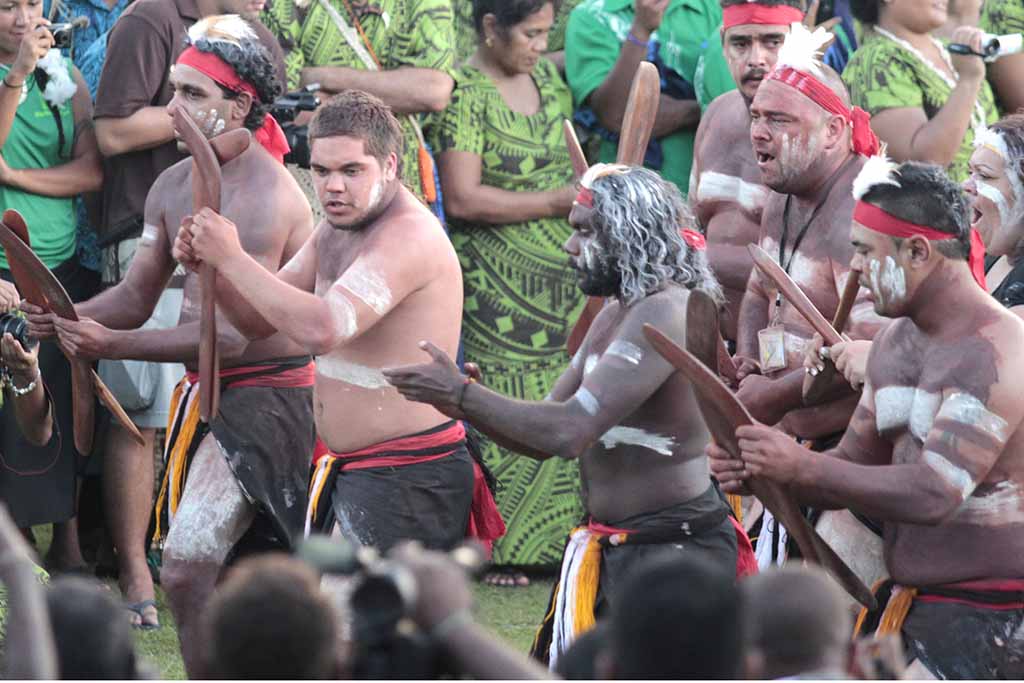
Important in Aboriginal spirituality is the notion of “Dreamtime,” or the beginning of the world. In the “Dreamtime,” the Ancestors rose from below the flat, featureless earth to form the various parts of the land, sea, sky and animals. The Ancestors, imbued with special powers, are believed to have metamorphosed into natural features of the landscape, such as rock formations and rivers, where their spirits continue to live. The Dreamtime continues today as the “Dreaming” in the spiritual lives of the Aboriginal peoples as they reenact their creation story with song, chant and dance.
Storytelling is a big part of Aboriginal culture. Many Aboriginal songs are about the Dreamtime and other folktales, often accompanied with drawings and dances. Artists needed to get permission to use certain stories in their work that do not belong to their family lineages. In the Northern Territory, Aboriginal sculptures, rock paintings, bark paintings, baskets and beadwork are traditionally prominent forms of art. Bark painting is considered the oldest form of Aboriginal art, although because of the nature of the materials–bark and ochre–which cause them to deteriorate rapidly, there are no ancient samples available today. However, many of aboriginal art pieces, such as paintings and sculptures, are created and accessible to visitors to places like Arnhem Land, Ubuirr and Nourlangie. Dot painting, another emergent form of more modern Aboriginal art, likely came about to obscure symbols and sacred knowledge from the white settlers or observers.
Aboriginal music is probably best known by the bamboo wind instrument called the didgeridoo. A didgeridoo is approximately five feet in length and produces a distinct low, humming and vibrating sound. Clap sticks are another aboriginal instrument used in music.
Tasmania
Map
Flag
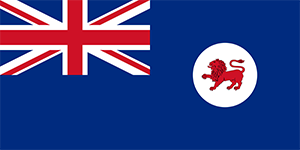
Quick facts
Official Name: Tasmania
Indigenous Peoples: Palawa, Indigenous Tasmanians
Official Languages: English
Political Status: State of Australia
Capital: Hobart
Population: 515,000
Greeting: Palawa kani: Ya (hi/hello) and ya pulingina (welcome)
Tasmania is an island state of the Commonwealth of Australia. Located about 240 km (150 mi) south of the state of Victoria in southeast Australia, it is separated from the mainland by Bass Strait. Tasmania also includes the surrounding 334 islands. The capital of Tasmania is Hobart, where almost half of the 515,000 residents live.
Tasmania is the 26th largest island in the world and has an area of 68,401 sq km (26,410 sq mi). Most of the island is set up as natural reserves and wilderness areas. The indigenous or Aboriginal peoples are known as Palawa, who in Tasmanian Aboriginal knowledge, was the first man.
History and geography
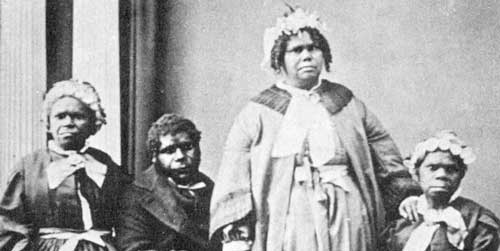
Tasmania is a place of breathtaking natural beauty. Much of the island is composed of dolerite rock, a kind of volcanic, basalt-type rock. In some parts the dolerite is in the form of large columns, creating distinctive mountains and cliffs. Central Tasmania is also largely composed of dolerite. In Hobart, the dolerite is underlaid with sedimentary sandstone rock. There are also granites and areas of limestone with huge caves.
Tasmania has a cool, temperate climate with four distinct seasons. Summer lasts from December to February, while autumn lasts between March and May. The winter months are between June and August and are generally the wettest and coldest months, with some areas receiving snowfall. Spring is generally the windiest time of the year. Rainfall amounts are variable and generally are larger on the western side of the island, while the more densely populated northern coast is drier.
Not much is known about the earliest settlers, but Tasmania is believed to have been first inhabited over 40,000 years ago. The original inhabitants became separated from the rest of the mainland Aboriginal groups about 10,000 years ago at the end of the last glacial period when sea levels rose, creating Bass Strait. The Tasmanians were not seafaring people so they were unable to maintain contact with their mainland relatives. As such, the technology of the Aboriginal Tasmanians was considered by archeologists to be quite simple, having been unable to learn of new innovations or materials from outside.
By the time the first European explorers arrived, the population was estimated to be between 3,000 to 7,000 individuals. There were nine major nations or ethnic groups. They were subsistence societies, using fire-stick farming to grow food, and hunted kangaroos, wallabies, seals and caught fish and shellfish, although there was a heavier reliance on land mammals for food. They called the island “Trouwunna,” and lived fairly undisturbed until the arrival of the first Europeans.
Dutch explorer Abel Tasman first arrived in the area in 1642. He named the island Anthony van Diemen, after the Governor of the Dutch East Indies who was his sponsor. The British renamed it Van Diemen’s Land, but later changed it to Tasmania in 1856. Other notable visitors include French explorer Bruni d’Entrecasteaux in 1792, Captain James Cook in 1773, and Captain William Bligh in 1788.
Sealers and whalers set up a base at Tasmania for provisions in 1798. Some of the sealers set up semi-permanent camps on uninhabited islands of Bass Strait, but still within easy distance of Tasmania. Trading relationships developed, and the Aboriginal Tasmanians became interested in hunting dogs and other western goods like four, tea and tobacco, for which they traded kangaroo skins. A trade in the labor of women to help the sealers capture seals and sea birds soon emerged; sometimes women were sold and sometimes, women were abducted from other tribes to be sold or traded.
Tasmania as a state was created in 1803 when Great Britain set up a penal colony to prevent France, which was exploring the southern coast of Australia, from claiming any land in the area. Around 75,000 convicts were sent until about 1853. Tasmania was originally a territory of New South Wales, but became a self-governing colony in 1825. In 1854 the Constitution of Tasmania was passed, and the territory was officially named Tasmania. In 1901, it became part of the Federation of Australia.
During the 1800s, as more and more white settlers came to the islands, tensions between the Aboriginal peoples and the British escalated. Conflicts arose over the need for common food sources, the loss of land to make way for grazing animals, and the taking of Aboriginal women as sexual partners for white settlers. Diseases, particularly by 1829, caused many deaths among the Aboriginal Tasmanians, killing most of the full-blooded population. Tensions, though, continued to rise and came to a head in what became known as the Black War, one of the earliest recorded modern genocides. The conflict reached a peak between 1825 and 1831, with guerrilla warfare being waged by the Tasmanians against the colonists. This led the government to declare martial law against the natives, keeping them from moving across boundaries without proper passes, and allowing them to be freely killed if they damaged or trespassed on settlers’ properties. In addition to martial law many lives were lost—over a thousand Aboriginal Tasmanians and settlers—through organized hunts and bounties for Aboriginal people.
In 1833, a Christian missionary sponsored by the Lieutenant Governor, persuaded about 200 survivors of the Black War to surrender with false assurances that they would be reunited with their families and communities. The real goal was the forced removal of the Aboriginal Tasmanians from Van Diemen’s Land and their placement in reserves in Flinders Island where they continued to suffer from disease. In March 1847, six Aboriginals petitioned Queen Victoria —the first of its kind—asking that the government keep the promises made to the native people. The last 47 living Aboriginal Tasmanians eventually were transferred to Oyster Cover, south of Hobart. Two individuals, Truganini and Fanny Cochrane Smith, believed to be the last people solely of Tasmanian descent, died in 1876 and 1905 respectively. As a result, all the indigenous Tasmanian languages were lost.
Tasmania became a self-governing colony of the British empire in 1856, and it began to slowly prosper economically, becoming a world center for shipbuilding in the late 19th century. By 1901, Tasmania united with the other five Australian colonies to form the Commonwealth of Australia.
Today, Tasmania’s population is more homogeneous than other states of Australia. Most residents are of British descent, directly descended from the 10,000 “founding families” that arrived in the mid-19th century.
Arts and culture
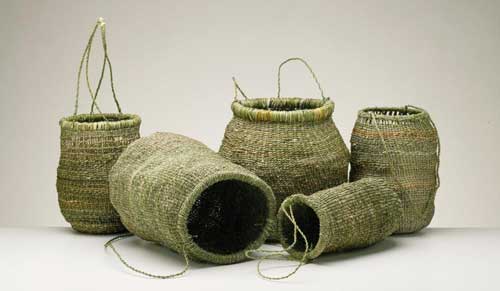
Tasmania has a vibrant modern music and arts scene. In the literary arts, works of fiction, non-fiction and children’s books are continually produced by local authors and writers. A variety of local productions are broadcast on the state’s various television stations, and all kinds of musical genres are performed by local musicians, from orchestras, to choirs, to modern heavy metal bands.
The traditional Tasmanian arts, though, emphasize artists’ connections to their land and culture. Inspiration is found in ancestral art forms, such as from petroglyphs embedded in rock surfaces, or through records of charcoal drawings on hut walls, even photographs of cicatrices or old scars incised on bodies. Like many other Pacific peoples, the Aboriginal Tasmanians were skilled at producing shell ornaments, as well as baskets finely woven from plant fibers.
Language loss has been a sad circumstance in Tasmania, with the original Tasmanian languages becoming extinct since 1905 with the death of the last native speaker. A recent project was developed to reconstruct the native language, Palawa, as a composite of a dozen original languages. Palawan kani, as this reconstructed language is known, is drawn from existing records and word lists compiled in journals by various people who interacted with the Tasmanian Aborigines. The language is not taught in state schools, but through other organized events and activities. Signs at public spaces such as national parks are written in Palawa kani, and some landmarks have been renamed using the language. The reconstructed Palawa kani language name for Tasmania is lutriwita.
Torres Strait Islands
Map
Flag
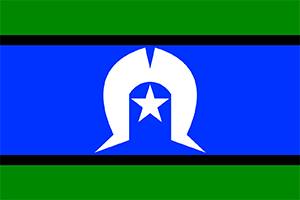
Quick facts
Official Name: Torres Strait Islands
Indigenous Peoples: Torres Strait Islanders (various ethnic groups)
Official Languages: English, other languages: Kala Lagaw Ya/Kala Kawaw Ya and Meriam, and Torres Strait Creole
Political Status: Territory of Australia (Part of Queensland)
Capital: Thursday Island
Population: 6,500 on the inhabited islands (15,000 in Queensland)
Greeting: Kala Lagaw Ya/Kala Kawaw Ya (Western Torres Straits): Kapu Goiga
The Torres Strait Islands are a small group of more than 274 islands that are part of the Australian state of Queensland in northern Australia. The islands are in the Torres Strait, a waterway that separates the Australian continent at Cape York Peninsula from Island New Guinea. Some of the islands, particularly Daru, are also part of Papua New Guinea’s Western Province. Only 14 of the islands are inhabited.
The capital of the Torres Strait Islands is Thursday Island, which is also where most of the government department offices are located. At the local level, each island community has their own elected council that runs their community’s domestic affairs.
History and geography
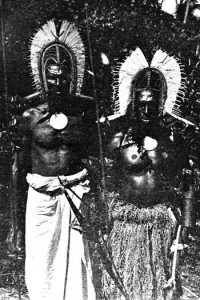
The Torres Strait Islands are distributed across an area of about 48,000 sq km (18,533 sq mi), with a total land area of about 556 sq km (215 sq mi). Much of the land is used for agriculture. The Torres Strait itself was formerly a land bridge that connected the Australian mainland with island New Guinea forming a single landmass called Sahul, or Australia-New Guinea. The land bridge was submerged with rising sea levels at the end of the last Ice Age about 12,000 years ago. The strait connects the Arafura Sea to the west and the Coral Sea to the east. The islands are rich with marine resources and many unique or rare species of plants and animals thrive among the different islands.
In 1606, Torres Strait was explored by Portuguese navigator Luis Vaz de Torres, for whom the strait is named. Torres was part of the Queiros expedition from Peru that was in search of the hypothetical continent Terra Australis, or South Land. One hundred seventy years later, British navigator Lt. James Cook claimed the eastern part of Australia for Great Britain. In 1792, British Naval Captain William Bligh entered Torres Strait and landed on the island of Erub, which he renamed Darnley Island. Violence marred the mission, but Bligh eventually was able to peacefully exchange goods with the natives.
Whalers and traders soon also began traveling through Torres Strait. In the early 1860s the beche-de-mer trade and pearl shell trade were well established. Missionaries of the London Missionary Society introduced Christianity to the islanders in 1871. The first school was opened in 1873 and a church was built in 1899. Continued contact with outsiders, though, brought diseases and caused many deaths.
In 1879, the Torres Strait Islands were annexed by Queensland and became part of the British colony until 1901, when Queensland became a state of Australia. A few years earlier the Queensland government passed the Aboriginal Protection and Restrictions of the Sale of Opium Act of 1897, a response to the notion in Queensland that the Aborigines were part of a “dying race.” However, the Torres Strait Islanders were initially excluded under this Act, but by 1904, they became subject to the Act’s provisions. Colonial administrators used the Act to take control of native lands and civil rights, restricting islander movements to and from the mainland. During the 1920s and 1930s, many Torres Strait Islanders were displaced from their lands and sent to live in reserves and missions across Queensland. In 1936, 70 percent of the Torres Strait Islander workforce went on strike challenging the authority of the government over their livelihoods and demanded protection against interference in wages, trade, and commerce. They also called for the lifting of evening curfews and the restriction of inter-island travel.
During World War II, Torres Strait Islander men were recruited to serve in the armed forces, forming the Torres Strait Light Infantry. They only received one-third of the pay given to White Australian servicemen. In protest, members of the infantry went on strike in 1943.
After the war, with the decline of the pearling industry, the native Islanders were allowed to settle on Thursday Island and the Australian continent.
In 1975, as Papua New Guinea negotiated its independence from Australia, PNG asserted their right to the Torres Strait Islands and their surrounding waters. The Islanders, however, insisted they were Australians over the objection of PNG. By 1978, when the treaty between PNG and Australia was signed, the two countries agreed the islands (and their inhabitants) would be an Australian territory, but the use of the sea area would be used by both countries. The Torres Strait treaty was enacted by 1985, and there are special provisions for free movement—i.e., traditional activities such as fishing, trading and family gatherings— without passports and visas between the two countries.
In 1993, the Torres Strait Regional Authority (TSRA) was established allowing Islanders to manage their own affairs according to their own ailan kastom (island custom) and to develop their own economic base. The Islanders, who are ethnically Melanesian, were given native land rights that would be administered by the TSRA. The TSRA had 20 elected representatives. In 2007, however, the Local Government Reform Commission recommended that the island councils be abolished, and the Torres Strait Island Regional Council (TSIRC) was established in its place. Members of the 15 communities vote for a local councillor and mayor.
Arts and culture
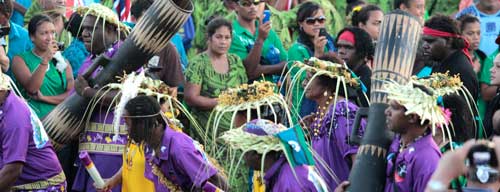
The indigenous people of the Torres Strait Islands are ethnically Melanesian. They are mostly similar to the coastal peoples of Papua New Guinea and culturally distinct from other Aboriginal people of the Australian mainland. However, there has always been regular contact and intermarriage between the two culture groups and there are two Torres Strait Islander communities on the nearby Queensland coast.
There are two indigenous languages spoken among Torres Strait Islanders—the Western-Central Torres Strait Language known variously as Kalaw Lagaw Ya, Kalaw Kawaw Ya and Kulkalgau Ya, and the Eastern Torres Strait language known as Meriam Mir. There is also a creole language that has evolved called Torres Strait Creole which is similar to the creole English Tok Pisin used in Papua New Guinea.
The indigenous Torres Strait Islanders are descendants of Papuan-Austronesian peoples based on linguistic and archeological evidence. They have a distinct culture but with slight variations depending on the community and the island in which they live. In general, they are seafarers, and traded regularly with their PNG neighbors to the north. In addition to seafaring the Torres Strait Islanders were agriculturalists as well as hunter-gatherers. They traditionally hunted dugong (manatee), turtle, crab, shellfish and other reef fish, and gathered wild fruits and vegetables. Some of these foods were important traditional foods used in ceremonies and celebrations.
Today, Torres Strait Islanders show cultural influences from the many different cultures they have been exposed to over the years since colonization, and in particular, Christianity (Protestant) is a dominant force in people’s lives.
Like other Aboriginal peoples, storytelling and crafts are a large part of Torres Island Strait arts. They are known for wame, using strings to create figures as a game (likened to the more familiar name “Cat’s Cradle”). Elaborate masks of tortoise shell or wood, nuts, feathers and sometimes human hair, depicting Ancestors and their associated totems for traditional ceremonial use, were another artistic craft of the Torres Strait Islanders. Islanders are also known for their skill in carving wood. More recent art includes printmaking, with artists using traditional motifs from carving and storytelling to depict the stories of Ancestors.
For further reading
“Aboriginal Australian Art & Culture – Alice Springs.” Last modified 27 February 2022.
Australian Broadcasting Corporation. “Charting the Pacific – Places.” Charting the Pacific, 13 October 1998.
Lehman, Greg. “The Palawa Voice.” The Companion to Tasmanian History, last modified 25 June 2012.
National Gallery of Australia. “National Gallery of Australia – Homepage.” Last modified 15 December 2022.
Queensland Government. “Aboriginal and Torres Strait Islander Community Histories.” Last modified 1 November 2017.
Shnukal, Anna. “Torres Strait Islanders.” In Multicultural Queensland 2001: 100 Years, 100 Communities, A Century of Contributions. Edited by Maximilian Brandle. Brisbane: State of Queensland, 2001.
Siasoco, Ricco Villanueva. “Aboriginal Australia: History and Culture of Australia’s Indigenous Peoples.” Last modified 28 February 2017.
Tasmanian Government Online. “Home.” Last modified 15 December 2022.
The World Factbook Archives. “Australia – The World Factbook.” Last modified 8 December 2022.
Melanesia delegations
- Australia
- Fiji
- New Caledonia
- Papua New Guinea
- Solomon Islands
- Vanuatu
